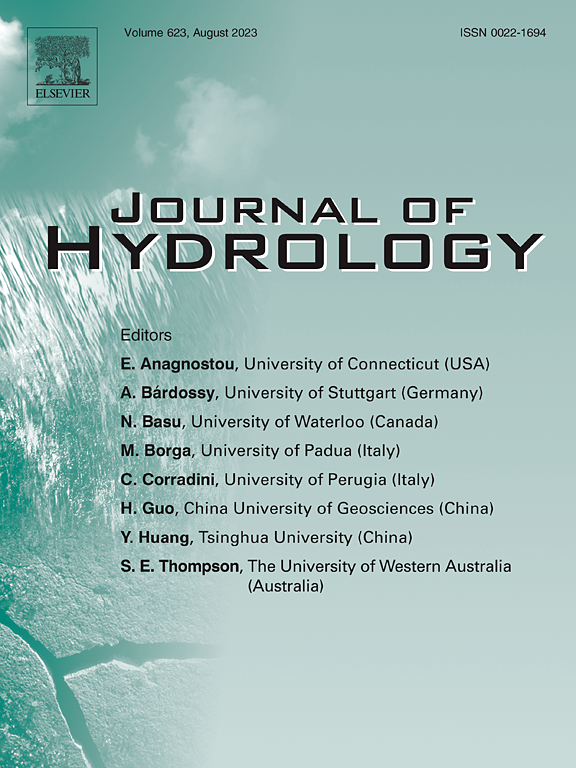Insights for river water resource management on the Qinghai–Tibet Plateau: Perspectives from stable isotopes and the ecological environment
IF 5.9
1区 地球科学
Q1 ENGINEERING, CIVIL
引用次数: 0
Abstract
Directly quantifying river evaporation loss and internal water vapor circulation on the Qinghai–Tibet Plateau (QTP) poses significant challenges. However, stable isotope technology has emerged as an effective method for revealing the internal dynamics of river water. This study was the first to estimate the evaporation loss and recirculating precipitation of rivers in summer on the QTP based on the stable isotope technology. Combined with remote sensing technology, the ecological and hydrological effects of river internal circulation on vegetation growth were revealed. Our findings revealed that the average river evaporation loss ratio was 14.86 % ± 1.2 %, whereas the average river recycled precipitation ratio was 12 % ± 0.36 % in summer on the QTP. Notably, the cumulative recycled precipitation of rivers in summer reached 702.5 × 108 m3, which was comparable to the water capacity of Qinghai Lake. Vegetation around the river on the QTP has demonstrated a nuanced nonlinear response to both river evaporation loss and recycled precipitation. Specifically, the normalized difference vegetation index (NDVI) value of 0.4 and the recycled precipitation of 10 mm emerged as critical thresholds, marking significant inflection points for vegetation growth promotion around the river. Notably, the regions with the highest river evaporation loss were concentrated in river source regions in summer, underscoring the necessity of implementing ecological stewardship in these critical zones. In light of these observations, it is imperative to consider the far-reaching ecological consequences of river evaporation loss and recycled precipitation, particularly within the river source regions on the QTP. The research and vigilant monitoring are essential to facilitate sustainable river water resource management and mitigate potential ecological disruptions in this ecologically sensitive region.
青藏高原河流水资源管理:稳定同位素与生态环境的视角
直接量化青藏高原河流蒸发损失和内部水汽循环是一项重大挑战。然而,稳定同位素技术已经成为揭示河水内部动态的有效方法。本研究首次基于稳定同位素技术在QTP上估算了夏季河流的蒸发损失和再循环降水。结合遥感技术,揭示了河流内循环对植被生长的生态水文效应。结果表明,青藏高原夏季河流平均蒸发损失率为14.86%±1.2%,而河流平均再循环降水率为12%±0.36%。值得注意的是,夏季河流累计循环降水达到702.5 × 108 m3,与青海湖的水量相当。QTP上河流周围植被对河流蒸发损失和再循环降水都表现出微妙的非线性响应。其中,归一化植被指数(NDVI)为0.4和循环降水为10 mm为临界阈值,标志着环河植被生长促进的显著拐点。值得注意的是,夏季河流蒸发损失最大的区域集中在河源区,强调了在这些关键区域实施生态管理的必要性。鉴于这些观测结果,必须考虑河流蒸发损失和再循环降水的深远生态后果,特别是在QTP的河源区域内。研究和监测对促进可持续的河流水资源管理和减轻生态敏感地区潜在的生态破坏至关重要。
本文章由计算机程序翻译,如有差异,请以英文原文为准。
求助全文
约1分钟内获得全文
求助全文
来源期刊

Journal of Hydrology
地学-地球科学综合
CiteScore
11.00
自引率
12.50%
发文量
1309
审稿时长
7.5 months
期刊介绍:
The Journal of Hydrology publishes original research papers and comprehensive reviews in all the subfields of the hydrological sciences including water based management and policy issues that impact on economics and society. These comprise, but are not limited to the physical, chemical, biogeochemical, stochastic and systems aspects of surface and groundwater hydrology, hydrometeorology and hydrogeology. Relevant topics incorporating the insights and methodologies of disciplines such as climatology, water resource systems, hydraulics, agrohydrology, geomorphology, soil science, instrumentation and remote sensing, civil and environmental engineering are included. Social science perspectives on hydrological problems such as resource and ecological economics, environmental sociology, psychology and behavioural science, management and policy analysis are also invited. Multi-and interdisciplinary analyses of hydrological problems are within scope. The science published in the Journal of Hydrology is relevant to catchment scales rather than exclusively to a local scale or site.
 求助内容:
求助内容: 应助结果提醒方式:
应助结果提醒方式:


